
A Trip along the Sunshine Coast
This year we decided to explore the whole sunshine coast with the Circuit Ferry ticket.
And so we started out right here in Comox:
What's to know about the Sunshine Coast?
- It is still a rainforest
- The only way to reach it is by plane or ferry – there are no roads leading here
- This 177 km stretch of coastline gets more sunshine than Vancouver
- It is named for its 2400 hours of sunshine annually
 Ferry Comox – Powell River
Ferry Comox – Powell RiverLucky for us, it was super nice and sunny… and so we enjoyed the ferry ride over to Powell River: you can not only see a nice shore line, but you have an amazing view on the Mountains of Vancouver Island: like our Glacier and all the snow-capped mountains, we normally don’t see… it is amazing and makes you aware of our great island.
And when you come closer to Powell River: you can see the mill
 Ocean front Camping
Ocean front CampingAnd right near the ferry station is the campground and even better if you have a truck and camper and fit in a tiny spot you can get ocean front even if you book last minute…
So out of the camper and down to the beach at the Willington Beach Campsite… so we often stepped down to the beach to see the sunset, enjoy the beach and relax.
 Hiking up on Valentin Mountain
Hiking up on Valentin MountainIf Gine reads viewpoint and that’s where we go: so very easy only a 260 m high summit and not even a half hour to walk (something Paul loves) and actually stairs are going up… so very soon we reach the top and they were right we had some amazing breathtaking views from here:
- We see the paper mill
- See the famous concrete ships
- Can see into the wild nature of BC’s undeveloped west coast
- See lots and lots of arbutus trees
- Enjoy the nice sitting on the stones
- We see the Powell Lake
- We have nice views on Texeda island, Savary island and Vancouver Island
 The amazing Arbutus tree
The amazing Arbutus tree- It is Canada’s only native broad-leafed evergreen tree
- They are found in drier areas
- They cling to the rocks and live in shallow nutrient poor soil
- They love the sun (like we do)
- The tree’s reddish bark peels off showing the new undergrowth underneath
- If they are damaged by fire, they can sprout fresh growth from the trunk
 Swimming at Powell Lake
Swimming at Powell LakeAnd now some relaxing: and so we went to the Mowat Bay Park on the Powell lake… really nice spot with sandy beach, grass… the perfect spot for us: you can swim or enjoy the view
What is so special about this lake?
- It is a fjord lake: 50 km long and 24 km wide
- In 1920 the Powell River company raised the dam a 2nd time and the lake rose to 56 m above sea level
 Sunset over the ocean and the island
Sunset over the ocean and the islandFacing west… we saw some gorgeous sunsets…
 Along Willingdon Beach trail
Along Willingdon Beach trailFamous for forestry this trail is so cool because it is history alive because you walk the rail bed from 1910: we see old artefacts from the forestry time like: a crane, an old wagon loaded with logs, and old steam donkey, a side winder, a caterpillar and a lot of staff I had no clue what it was – you cross a little trestle and then you end up again on the beach
And that’s what is so interesting about the forestry here:
- Powel River is a forestry town
- They started logging in 1880 – in the old days they pulled the logs out by oxen: 7 pairs pulling 2 logs
- Between 1924-28 the old growth logging was in its heydays
- By the 1940s the chain saw replaced the cross cut hand saw
 The concrete ships
The concrete shipsThis is one cool breakwater: some concrete ships… we already saw them from the Valentine mountain and the ferry… today we walked out on a stone breakwater to come closer to them and see those old ship skeletons a little bit better… it is amazing…
Why someone would built a ship of concrete?
- Of all the concrete ships built in WWI & WWII – 10 are still afloat and they are right here
- 9 of the ships are from WWII and one from WWI
- Because of the shortage of steel – they built concrete ships
- The largest collection of concrete ships is right here
- The SS Peralta an oil tank built in 1921 – came in 1958 to Powell river – she is the last concrete ship from WWI still afloat – she is also the longest concrete ship every built 420 ft. long
- They could only go 10 knots
- The ships are anchored with 16 ton concrete anchors and 8-10 anchors per ship
- It is a floating breakwater
 a chain of iron
a chain of ironeven better there are a lot of iron chains hanging on the rocks here… so Gine convinced Paul that it would be amazing to have one of those at home… and so we not only carried back over the stones but also along the trail back to the campsite and drove it around for 2 more weeks until it finally found it’s spot on our patio… I’m sure it is from the very first discoverers of this coast.
Historic Powell River
Some interesting Facts about Powell River:
- It’s the largest community on the Sunshine coast
- It was the 1st pulp and paper town in Western Canada: built in 1909: the 1st paper rolled of in 1912 of the No 1 paper mill: a year later they had 4 paper mills and run 650 ft. per sec and was the fastest in the world at this time, producing 250 tons of paper a day – in the 1960s it was the highest produce of wood fibre paper and paper news print in the world
- It has a historic town site with over 400 houses built between 1910 – 1930
- It began to flourish in 1908 when the logging started: the town was preplanned in 1909 and methodically built block by block with up to 7 homes built simultaneously: they built the town for the workers with parkland planned around the town
- The Powell River is the 2nd shortest river in the world: only 500 m long
- It’s named in 1881 after Dr. Israel Wood Powell a medical doctor from Ontario who worked for the BC government during the 1880s
- It had the 1st dial phone in BC
- It had the 1st total wheel chair accessible lake
- It had the 1st forestry lookout in Canada on Mt Pocahontas in 1924 (on Texeda Island)
- It has the oldest operating movie theatre in BC – used since 1928
- It had the 1st radio telephone in BC

Starting out with the 2 churches facing each other and both are built from the resident’s resources
- The St. Johns church from 1913 built as a non-denomination place or united for all protestants is the one with the tiny steeple: and since the Powell river company had a policy to keep themselves removed from the communities religious activities, they didn’t built the church but gave a big donation
- St. Joseph church, which got built in 1916 is the catholic church
 The Patricia theatre from 1928 is Spanish renaissance style is the oldest operating movie theatre in BC
The Patricia theatre from 1928 is Spanish renaissance style is the oldest operating movie theatre in BC The Federal building from 1930s is in nice red brick style: and it should show the strength and stability of the government
The Federal building from 1930s is in nice red brick style: and it should show the strength and stability of the government You find the Bank of Montreal – this mock-Tudor structure is from 1931
You find the Bank of Montreal – this mock-Tudor structure is from 1931 The Provincial Building from 1939 had the Police and courtroom including the prison cells
The Provincial Building from 1939 had the Police and courtroom including the prison cells St. Luke’s hospital built in 1913 – a big square building and before it they had a tent hospital
St. Luke’s hospital built in 1913 – a big square building and before it they had a tent hospital And then you can see all those old cute little gable houses
And then you can see all those old cute little gable houses
 It’s raining on the other side of the strait
It’s raining on the other side of the straitIf you sit in the sunshine and you can see the rain and the clouds on Vancouver Island… then you are happy you are here… and part of our vacation this year was to always check out where is the weather better… let’s always drive towards the sun.

 Powell River, British Columbia, Canada
Powell River, British Columbia, Canada

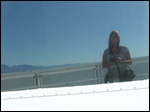
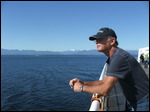











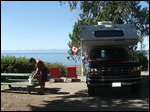

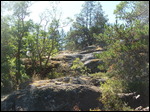



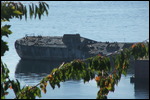

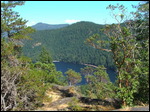

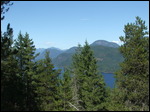
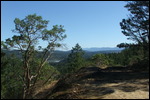
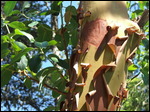



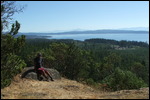
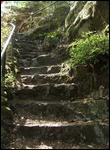
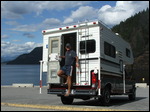

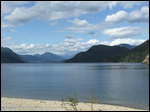

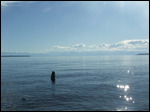
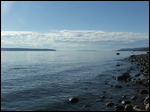

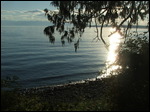


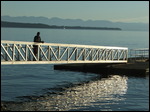
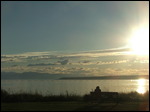
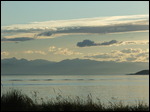
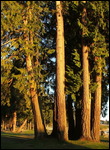
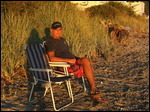

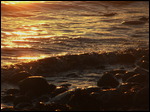
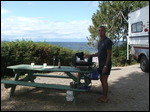
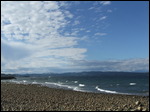
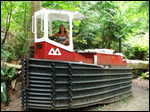
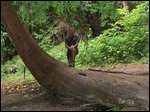
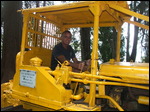

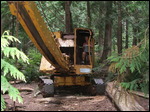
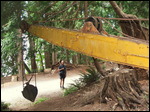

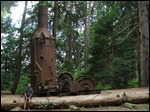
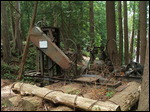
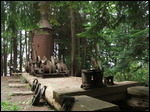
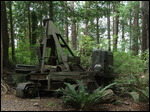
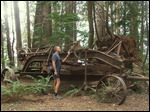




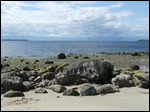

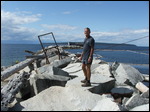


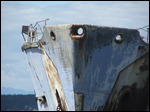

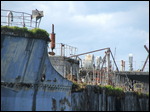
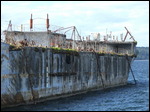




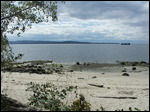

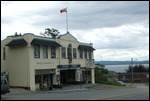


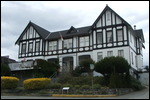
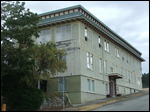


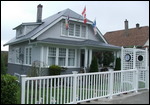
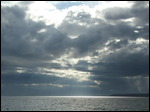
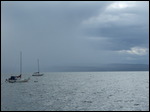
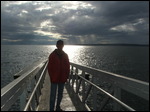
2025-05-22